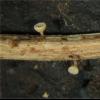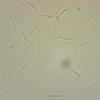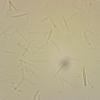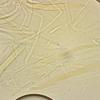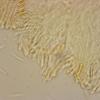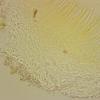
28-04-2013 17:04
 Gilles Corriol
Gilles Corriol
Bonjour,Voici une récolte de l'an dernier (GC1211

29-04-2013 10:03
Bonjour j'ai trouvé ce spécimen en forêt tropic

26-04-2013 11:36
 Gilles Corriol
Gilles Corriol
Un autre dans les Dermataceae cette fois. GC130421

27-04-2013 09:22
 Maren Kamke
Maren Kamke
Hello, Another find this time on Phragmites sp.

28-04-2013 09:52
 Nicolas VAN VOOREN
Nicolas VAN VOOREN
Bonjour.Je suis à la recherche de l'article suiva
Crocicreas dolosellum ?
Gilles Corriol,
28-04-2013 17:04
 Bonjour,
Bonjour,Voici une récolte de l'an dernier (GC12112210), étudiée avec réactifs non orthodoxes ...
Sur tige herbacée.
Spores étroitement fusiformes 13,1-18,2 x 2,2-2,8 µm, 0-1 septées, faiblement guttulées.
Asques environ 70x7 µm, 8 sp., bisériés, bouclés, I+ (au fait, un asque ou une asque en français ?)
Paraphyses cylindriques, x 2-2,5 µm, non ramifiées, non septées.
Trame à hyphes allongées, gélifiées.
Poils externes cylindriques, à contenu granuleux, jaune d'or.
Merci pour vos critiques et avis !
Hans-Otto Baral,
28-04-2013 18:13

Re : Crocicreas dolosellum ?
Can you exclude Fraxinus petioles? Because the features remind me of Cyathicula fraxinophila.
C. dolosella has 1-septate spores already inside the living asci, C. fraxinophila only outside or in dead asci.
C. fraxinophila has croziers, my C. dolosella (5188) not.
C. dolosella has 1-septate spores already inside the living asci, C. fraxinophila only outside or in dead asci.
C. fraxinophila has croziers, my C. dolosella (5188) not.
Gilles Corriol,
29-04-2013 09:19

Re : Crocicreas dolosellum ?
Substrate is likely to be Fraxinus excelsior petiole. Only very few mature spores were septed. C. fraxinophilus seems a very good candidate.
It seems that spores also were too long for C. dolosellum.
Thank you Zotto.
It seems that spores also were too long for C. dolosellum.
Thank you Zotto.
Hans-Otto Baral,
29-04-2013 09:22

Re : Crocicreas dolosellum ?
Frax petioles you can easily recognize by their scars (two at each internodium) where the leaftes emerged.
Gilles Corriol,
29-04-2013 15:58

Re : Crocicreas dolosellum ?
I confirm there are such scars.

